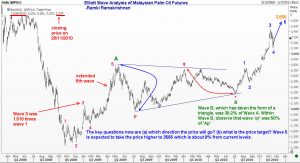 In the short period of just four months from July, Malaysian Palm Oil futures had rallied from 2,270 to 3,542 ringgit, or almost 56%. Global demand has been larger than supply for the first time in eight years, and China, the biggest user of commodities, has seen its reliance on imported vegetable oils grow to an ‘alarming level’. The steep increase in prices has prompted action from Chinese authorities who have imposed restrictions on bank credit to speculate in agricultural markets and also started selling some oil from state reserves. These actions have caused prices to correct down a bit, but there are other signs that the price of Palm Oil could start climbing again. Heavy rains may curb production, while at the same time demand remains strong not just from China but also from the European Union. Malaysian exports have seen a strong rise in November compared to October. From a technical point of view also the market is likely to start climbing again in the coming days.
In the short period of just four months from July, Malaysian Palm Oil futures had rallied from 2,270 to 3,542 ringgit, or almost 56%. Global demand has been larger than supply for the first time in eight years, and China, the biggest user of commodities, has seen its reliance on imported vegetable oils grow to an ‘alarming level’. The steep increase in prices has prompted action from Chinese authorities who have imposed restrictions on bank credit to speculate in agricultural markets and also started selling some oil from state reserves. These actions have caused prices to correct down a bit, but there are other signs that the price of Palm Oil could start climbing again. Heavy rains may curb production, while at the same time demand remains strong not just from China but also from the European Union. Malaysian exports have seen a strong rise in November compared to October. From a technical point of view also the market is likely to start climbing again in the coming days.
Elliott Wave Analysis of the benchmark February 2011 contract shows that the rally from the July low has completed only four out of the required five waves that are normal in any trend. The 3rd wave was 200% of the 1st wave. In any progression, only one of the impulse waves is expected to be ‘extended’ and the 3rd wave has clearly been an extended wave. This means the 5th wave has a reasonable chance of travelling a distance equal to the 1st wave. The target for the 5th wave thus lies around 3,565 ringgit. The chart above carries annotations of how to interpret the moves from a technical point of view

